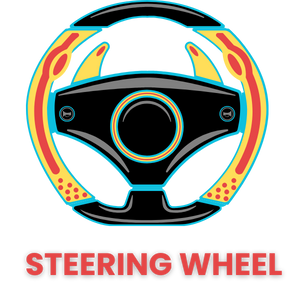Why Is My Steering Wheel Hard to Turn? Reasons & Easy Fixes
Have you ever found yourself struggling to turn your steering wheel, perhaps during a crucial moment while driving?
I will describe how this issue can be not only frustrating but also potentially dangerous. Understanding why your steering wheel becomes hard to turn is essential for maintaining vehicle safety and performance.
In this comprehensive blog post, I will cover everything from the causes and diagnosis to solutions and preventive measures for a hard-to-turn steering wheel.
Understanding the Steering System
How the Steering System Works
The steering system in your car is a complex mechanism designed to provide you with precise control over your vehicle. It includes components such as the steering column, rack and pinion, power steering pump, and the power steering fluid. There are primarily two types of steering systems: hydraulic power steering (HPS) and electric power steering (EPS).
- Hydraulic Power Steering (HPS):
- Uses hydraulic pressure generated by a power steering pump, which is driven by the engine via a belt and pulley system.
- The fluid is stored in a reservoir and is pumped into the steering gear, aiding in the movement of the wheels.
- Electric Power Steering (EPS):
- Utilizes an electric motor and sensors to provide steering assistance.
- It is more energy-efficient and offers variable assistance depending on driving conditions.
Understanding these components and their functions is crucial in diagnosing and solving steering issues.
| More to Explore for You Interest: You Might Also Enjoy to Read | |
| 1 | Steering Wheel Shakes When Braking: 5 Great Truths You Need |
| 2 | How to unlock steering wheel without key: 5 Proven Ways |
| 3 | Steering Wheel Shakes When Driving: 5Amazing Causes & Fixes |
Common Causes of a Hard-to-Turn Steering Wheel
Low Power Steering Fluid
Low power steering fluid is a common reason for a hard-to-turn steering wheel. The power steering system relies on hydraulic fluid to create the pressure needed for easy steering.
- How It Affects Steering: Without sufficient fluid, the pump cannot generate the necessary pressure, making the steering wheel difficult to turn.
- Signs: Unusual noises when turning the wheel, difficulty in steering.
- Potential Leaks: Leaks can occur in the power steering pump, hoses, or the rack and pinion assembly.
Faulty Power Steering Pump
The power steering pump is responsible for pressurizing the fluid that helps you steer easily.
- Role of the Pump: It maintains the hydraulic pressure needed for smooth steering.
- Symptoms of a Failing Pump: Whining or groaning noises, increased steering effort.
- Consequences: Ignoring a faulty pump can lead to complete steering failure.
Worn or Broken Serpentine Belt
The serpentine belt drives multiple components, including the power steering pump.
- Function: Powers the pump to ensure consistent hydraulic pressure.
- Signs of Belt Issues: Squealing noises, visible cracks or wear on the belt.
- Cost and Replacement: Typically costs between $25 and $75, with labor costs adding another $75 to $150.
Steering Rack Problems
The steering rack is a critical component in the steering system.
- Importance: Connects the steering wheel to the wheels, translating your inputs into wheel movements.
- Symptoms: Difficulty turning the wheel, especially at low speeds, uneven tire wear.
- Repair Costs: Replacement can range from $400 to $800, with additional costs for labor and alignment.
Low Tire Pressure
Tire pressure significantly affects steering performance.
- How It Affects Steering: Low tire pressure increases friction and makes turning the wheel harder.
- Signs: Vehicle pulls to one side, uneven tire wear.
- Simple Fix: Regularly check and maintain proper tire pressure.
Old or Contaminated Power Steering Fluid
Old or dirty power steering fluid can reduce the efficiency of the steering system.
- Effects: Causes wear on the pump and other components, leading to harder steering.
- Maintenance Intervals: Replace power steering fluid every 70,000 to 100,000 miles to ensure optimal performance.
Diagnosis of hard-to-turn steering wheel
Visual and Physical Inspection
Diagnosing a hard-to-turn steering wheel begins with a thorough inspection.
- Checking Fluid Levels: Locate the power steering fluid reservoir and check the fluid level. Top up if necessary.
- Inspecting the Serpentine Belt: Look for signs of wear such as cracks or fraying.
- Other Components: Inspect the steering rack, tie rods, and other steering components for wear or damage.
Listening for Unusual Noises
Sounds can be a significant indicator of steering issues.
- Whining or Groaning: Often points to a problem with the power steering pump.
- Squealing: Typically indicates a worn or loose serpentine belt.
Professional Diagnosis
Sometimes, professional help is necessary.
- When to Consult a Mechanic: If the problem persists despite basic checks, it’s time to see a professional.
- Diagnostic Tools: Mechanics use specialized tools to diagnose issues more accurately.
Solutions and Repairs

Refilling or Replacing Power Steering Fluid
If low fluid levels are the issue, refilling might solve the problem.
- Steps to Refill:
- Locate the reservoir.
- Clean the area around the cap.
- Check the fluid level and add the manufacturer-recommended fluid if necessary.
- Types of Fluid: Ensure you use the correct type for your vehicle.
Replacing the Power Steering Pump
If the pump is faulty, replacement may be necessary.
- Replacement Process:
- Drain the old fluid.
- Remove the old pump.
- Install the new pump and refill with fresh fluid.
- Cost Considerations: Typically costs between $200 and $500 for parts and labor.
Serpentine Belt Replacement
A worn serpentine belt can significantly affect steering.
- Replacement Steps:
- Inspect the belt for wear.
- Remove the old belt.
- Install the new belt.
- Safety Precautions: Ensure the engine is off and cool before beginning.
Steering Rack Replacement
A damaged steering rack often needs to be replaced.
- Signs of Replacement Needed: Persistent difficulty in steering, uneven tire wear.
- Process:
- Remove the old rack.
- Install the new rack.
- Perform a wheel alignment.
- Costs: Replacement can cost between $600 and $1200 including parts and labor.
Preventive Measures
Regular Maintenance
Routine checks and servicing are crucial for preventing steering issues.
- Maintenance Schedule: Follow your vehicle’s maintenance schedule for regular inspections.
- Component Checks: Regularly check the power steering fluid, belts, and other steering components.
Proper Tire Care
Maintaining correct tire pressure is vital.
- Tire Pressure: Check tire pressure regularly and keep it at the manufacturer-recommended levels.
- Rotation and Alignment: Regularly rotate and align your tires to prevent uneven wear and maintain steering performance.
Fluid Checks and Changes
Keeping your power steering fluid clean and at the right level is essential.
- Regular Inspection: Check fluid levels and condition regularly.
- Timely Replacement: Change power steering fluid as recommended by your vehicle’s manufacturer.
Product Comparisons
Power Steering Fluid Brands
Comparison Table:
| Brand | Features | Pros | Cons | Price (USD) |
| Lucas | High-temperature stability | Long-lasting, Reduces wear | Expensive | $20 |
| Prestone | Anti-foam formula | Smooth steering | Needs frequent top-ups | $15 |
| Royal Purple | Universal compatibility | Affordable | Moderate performance | $10 |
Power Steering Pumps
Top-Rated Pumps:
| Brand | Features | Pros | Cons | Price (USD) |
| ACDelco | High pressure, Durable | Efficient, Reliable | Expensive | $150 |
| Cardone | Quiet operation, Easy installation | Affordable | Limited warranty | $120 |
| Bosch | High flow rate, Compact design | High performance | Needs professional installation | $180 |
Serpentine Belts
Best Belts Available:
| Brand | Durability | Compatibility | Price (USD) | Purchase Link |
| Gates | High | Universal | $35 | Gates Serpentine Belt |
| Dayco | Medium | Limited | $25 | Dayco Serpentine Belt |
| Continental | High | Specific to certain models | $45 | Continental Serpentine Belt |
Tips:
- Ensure Compatibility: Always check if the fluid or part is compatible with your vehicle. Using the wrong type can cause damage and void warranties.
- Regular Maintenance: Regular checks and maintenance can prevent major issues down the line.
- Purchase from Reliable Sources: Always buy from trusted brands and sellers to ensure product quality and authenticity.
By comparing these products and using the provided links, you can easily find and purchase the best options for your vehicle’s needs.
Expert Opinions
Interviews with Mechanics
-
Insights:
-
- Common Steering Issues and How to Avoid Them:
- Noisy Steering: Noisy steering is frequently caused by a loose or worn power steering belt, low power steering fluid, or issues with the steering gear. Mechanics recommend regular maintenance checks and timely fluid top-ups to prevent these problems. For detailed guidance, watch this YouTube video on diagnosing steering noises.
- Excessive Vibrations: Excessive steering wheel vibrations are often due to wheel alignment issues, engine problems, or worn brake pads and calipers. Regular wheel balancing and alignment checks are essential for a smooth ride.
- Steering Wheel Slippage: Slipping or loose steering wheels can result from worn steering belts, leaking steering pumps, or worn steering rack mounts. Prompt replacement of these components is recommended.
- Common Steering Issues and How to Avoid Them:
- Tips on Maintaining Steering Components:
-
- Regularly check and maintain power steering fluid levels.
- Schedule periodic inspections for the power steering pump and belts.
- Ensure proper tire rotation and balancing to avoid uneven tire wear and associated steering issues.
Customer Reviews
-
Experiences:
- Real-life Experiences of Vehicle Owners Dealing with Steering Issues:
- Many vehicle owners have reported resolving steering wheel vibrations at high speeds by getting their wheels balanced and aligned.
- Some owners fixed noisy steering by addressing power steering fluid leaks and refilling the fluid. Detailed feedback can be found in this YouTube video.
- Feedback on Different Solutions and Products:
- Customers who replaced worn-out steering components like tie rods and steering racks noticed a significant improvement in steering performance.
- Positive feedback has also been given to high-quality aftermarket upgrades for steering components, which tend to last longer and perform better.
- Real-life Experiences of Vehicle Owners Dealing with Steering Issues:
For more detailed discussions and interviews with mechanics on steering issues, you can visit the following videos:
- Fix Steering & Suspension Noises
- Fixing Steering Wheel Slippage
- Customer Reviews on Steering Solutions
Conclusion
Understanding why your steering wheel is hard to turn is crucial for maintaining your vehicle’s safety and performance. From low power steering fluid to a faulty steering rack, addressing these issues promptly can save you from costly repairs and dangerous driving conditions. Regular maintenance, proper tire care, and timely fluid checks are essential preventive measures.
Frequently Asked Questions
Q No. 1: What does it mean when your steering wheel is hard to turn?
Answer: When your steering wheel is hard to turn, it typically indicates an issue with the power steering system. This problem can stem from various sources such as low power steering fluid, a damaged power steering pump, a malfunctioning steering rack, or issues with the steering linkage. The power steering system is designed to make turning the steering wheel easier, so when it fails, the steering becomes much more difficult.
Q No. 2: What can cause the steering wheel to be harder to turn than usual?
Answer: Several factors can cause the steering wheel to be harder to turn than usual:
- Low Power Steering Fluid: A common cause, often due to leaks in the system.
- Worn or Damaged Power Steering Pump: If the pump is failing, it cannot provide adequate pressure.
- Steering Rack Issues: Problems within the steering rack, such as wear and tear, can cause stiffness.
- Serpentine Belt Problems: If the belt driving the power steering pump is loose or broken, the pump won’t work effectively.
- Tire Pressure: Low tire pressure increases resistance, making steering harder.
Q No. 3: How can I make my steering wheel easier to turn?
Answer: To make your steering wheel easier to turn, consider the following steps:
- Check and Top Up Power Steering Fluid: Ensure the fluid is at the correct level.
- Inspect the Power Steering Pump: Look for signs of wear or damage and replace if necessary.
- Examine the Steering Rack: Regular maintenance can help detect and resolve issues early.
- Check Tire Pressure: Ensure all tires are inflated to the recommended pressure.
- Inspect the Serpentine Belt: Replace it if it’s worn or damaged to ensure the power steering pump operates correctly.
Q No. 4: What is the cause of heavy steering?
Answer: Heavy steering is primarily caused by issues within the power steering system. Common causes include:
- Low or Leaking Power Steering Fluid: Reduces the hydraulic pressure needed for easy steering.
- Faulty Power Steering Pump: Prevents adequate hydraulic pressure from being generated.
- Steering Rack Problems: Wear and tear can create resistance in the steering mechanism.
- Worn Out Suspension Components: Can also affect steering ease.
Q No. 5: How do you fix a stiff steering wheel?
Answer: To fix a stiff steering wheel, follow these steps:
- Check Power Steering Fluid Levels: Refill if low and check for leaks.
- Inspect and Replace the Power Steering Pump: If it’s malfunctioning, a new pump may be required.
- Examine the Steering Rack: Repair or replace if it’s damaged.
- Check the Serpentine Belt: Ensure it’s not loose or worn.
- Inflate Tires to the Correct Pressure: Low tire pressure can cause stiffness.
Q No. 6: Why is my steering wheel hard to turn but has power steering fluid?
Answer: If your steering wheel is hard to turn despite having sufficient power steering fluid, possible causes include:
- Faulty Power Steering Pump: The pump might not be generating enough pressure.
- Clogged Power Steering Lines: Blockages can impede fluid flow.
- Damaged Steering Rack: Internal issues can make steering difficult.
- Worn Serpentine Belt: A loose or damaged belt can affect the pump’s performance.
Q No. 7: What can cause the steering wheel to be harder to turn than usual?
Answer: Repeating for clarity, the steering wheel can be harder to turn than usual due to:
- Low Power Steering Fluid: Often due to leaks.
- Power Steering Pump Failure: The pump is crucial for maintaining hydraulic pressure.
- Steering Rack Damage: Wear and tear can cause increased resistance.
- Tire Pressure Issues: Low tire pressure makes steering more difficult.
- Serpentine Belt Problems: A worn or broken belt affects the power steering pump.
Q No. 8: How can I make my steering wheel easier to turn?
Answer: To reiterate, you can make your steering wheel easier to turn by:
- Ensuring Power Steering Fluid Levels are Correct: Top up if necessary.
- Inspecting the Power Steering Pump: Replace if faulty.
- Maintaining the Steering Rack: Regular checks and maintenance.
- Keeping Tires Properly Inflated: Correct tire pressure reduces resistance.
- Checking the Serpentine Belt: Replace if worn or damaged.
By addressing these potential issues, you can improve your vehicle’s steering ease and ensure a smoother driving experience.








Leave a Reply